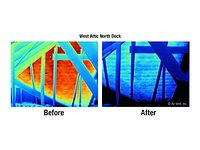
Energy
Shield owner David Fritzinger said the Somerset job utilized a Bayer roof
system and was inspected by an independent third party before receiving the top
score for being correctly installed, which resulted in a15-year systems
warranty from the manufacturer. (Photos by Tom Watts.)
With energy costs a paramount consideration in today’s economic climate; spray polyurethane foam (SPF) continues to be a viable option because of its ability to help reduce commercial and residential heating costs.
And one company in Michigan - Energy Shield Inc. - is still showing why spray foam reroofing is the way for businesses and homeowners to save money in the future.
This year marks the 30th anniversary of Energy Shield Inc. of Pontiac, Mich., which has primarily focused on SPF roofing.
The company got its start in 1974 as Energy Seal, but incorporated in early 1978 as Energy Shield, according to David Fritzinger, president of Energy Shield Inc.

Somerset
Inn in Troy, Mich., located about eight miles north of Detroit, needed 24,000
square feet of roof replaced with SPF roofing.
“It was during the first Arab oil boycott that I made the decision to leave the coatings business and strike out on my own and become a sprayfoam insulation contractor,” Fritzinger said. “Insulation was becoming a buzzword because of the energy crises, and I thought I could make a go at it.”
The first few years were focused mostly on SPF insulation projects, but roofing opportunities started to develop in 1978 and 1979, Fritzinger said.
“Initially they were mostly small jobs or where I worked as a sub to another contractor, but the number of jobs, size of work and gross revenues in the SPF roofing market grew significantly in the 80s,” he said.
By 1990, Energy Shield was an established SPF roofing contractor working in Michigan, Ohio and Indiana.

The
Somerset Inn property was experiencing leaking from a roof that was only 10
years old. The existing roof was a modified bitumen membrane hot-mopped to 2
inches of fiberglass insulation, and fully adhered to a concrete deck.
Somerset Inn in Troy, Mich., is the most recent notable metropolitan Detroit hotel job that Energy Shield has completed. Somerset Inn, located about eight miles north of Detroit, needed 24,000 square feet of roof replaced with SPF roofing.
The Somerset property, owned by a private developer, was experiencing leaking from a roof that was only 10 years old. The existing roof at Somerset was a modified bitumen membrane hot-mopped to 2 inches of fiberglass insulation, and fully adhered to a concrete deck. Some of the fiberglass (less than 15 percent) was wet. However, the owner elected not to have this removed.
“Energy Shield provided information from Oak Ridge Laboratories documenting the results of a test conducted in 1995 where a SPF roof was applied over an existing asphalt membrane roof that has wet fiberglass insulation,” Fritzinger said. “With venting, the fiberglass dried out completely.”
Energy Shield approached the job with open arms by conducting the following checklist:
- The roof was cleaned and all dirt, debris and defective material was removed.
- The existing roof was extensively penetrated to enhance drying with vents at rate of one per 500 square feet in wet areas.
- A uniform seamless 11/2-inch, 3-pound density BaySystems SPF was applied over the entire surface and flashed up and onto all vertical curbs, penetrations and terminations.
- The company installed the Bayer/GE silicone rubber membrane base coat with tan granule surfacing over the SPF.
Fritzinger said the ability of an SPF roof to be applied over an existing BUR was essential to the installation.
Perhaps most important on the Somerset job were the safety measures used by Energy Shield, including a perimeter edge warning line and full-body harness with secured tie-offs for anyone positioned at the roof’s edge. “And periodic rooftop safety talks,” Fritzinger said.
Wyndham Gardens Reroof
Energy Shield received an “Industry Excellence Award” from the Spray Polyurethane Foam Alliance this year for work on the Wyndham Gardens Hotel in Novi, Mich., now a Doubletree hotel.
The total roof replacement included 52,500 square feet of roof space, and used BaySystems foam with light tan silicone granules.
At the time of the project, the hotel was 18 years old and had two separate layers of EPDM rubber held in place by river-rock ballast. One layer was installed initially, while a second layer was applied 10 years later. “And the roof always leaked,” Fritzinger said.
The roof deck was lightweight tapered concrete, and there was no additional insulation.
The roof replacement project began with full removal of the EPDM rubber roofs and rock ballast down to the deck.
Fritzinger said Energy Shield mechanically attached a Firestone MB base sheet using special fasteners. Over the base sheet, Energy Shield spray-applied a 2-inch average of SPF at 3-pound density, and coated the foam with the GE/Bayer tan silicone membrane with tan granules into the top coat.
According to Fritzinger, the foam provided for an effective means of sealing around hundreds of penetrations and around the perimeter. It also provided a more walkable surface compared to the river rock, and an R-14 insulation value was added to the building.
The job was completed in May 2007 “and has not leaked since,” Fritzinger said.

Energy
Shield used a uniform seamless 11/2-inch, 3-pound density BaySystems SPF, which
was applied over the entire surface and flashed up and onto all vertical curbs,
penetrations and terminations.
Energy Shield’s largest single application of SPF roofing was the former Ford Sheldon Road facility in Plymouth, Mich., which is now an Automotive Components Holding LLC plant, but still produces heater and air conditioning units primarily for Ford Motor Company. The plant has about 1 million square feet of roofing and was originally an aggregate surfaced BUR over fiberglass insulation.
Starting in 1989, Energy Shield began reroofing the facility with a silicone rubber membrane/SPF roof system, and the bulk of the work was completed in 1990. About five years ago, Energy Shield recoated the entire roof and made repairs to areas that had been damaged.
“During this application, light-gray ceramic roofing granules were incorporated in the GE silicone rubber topcoat,” Fritzinger said. “This application improved the abrasion resistance of the membrane and made the roof safer for foot traffic during the frosty months.”
Cutting Energy Costs
A top feature of SPF roofing is the insulation ability of spray foam. “We have numerous responses from our customers as to the improvement in building comfort and savings realized in energy bills, mostly heating,” Fritzinger said.
One such case was Teal Electric in Troy, Mich., where Energy Shield applied an SPF roof 24 years ago.
“The owner was pleasantly surprised at the reduction in his gas bills the first full winter after installing our GE silicone rubber/SPF roof,” Fritzinger said, noting fuel consumption was reduced 34 percent. “To this very day, Teal is enjoying similar savings from their SPF roof, which is still functioning and has never been recoated.”
Another feature about SPF roofing that Energy Shield likes to stress is its ability to waterproof metal roofed buildings and provide substantial insulation.
“We installed the GE silicone rubber/SPF roof onto the metal-roofed portion of the DMS building for the city of Plymouth (Mich.),” Fritzinger said. “The application was about 11/2 inches of SPF applied directly to the fluted metal roof surface, then coated with the GE silicon rubber with granule surfacing. The total DMS building is about two-thirds metal roof and one-third two-story shingle, so the heat bills go to heat the entire building, not just the metal-roofed portion.”
In 2007, the city of Plymouth shared with Energy Shield its energy consumption bills dating back six years. “The reduction in gas consumption was greater than 25 percent and with rising gas prices the dollars saved was over $35,000,” Fritzinger said. “At this rate, the city will realize a simple payoff of the roof in less than 10 years. And it will still have another five years on the warranty at that time.”
The city of Plymouth now utilizes SPF roofing on their City Hall, ice arena, and community cultural center buildings.

Energy
Shield’s roofing business is 100 percent commercial/institutional, while about
25 percent of Energy Shield’s SPF insulation business is residential.
SPF roofing is a perfect solution for roof replacement on older historic buildings, according to Fritzinger.
“Many of the buildings constructed in the late 19th and 20th centuries are a real challenge when it comes to waterproofing,” he said. “SPF is well-suited for this because the system is fully adhered and forms itself around the many ornamental structures with varying angles and degrees of elevation.”
A good example, Fritzinger said, is the Old Gym (circa 1888) at Orchard Lake St. Mary’s College in suburban Detroit.
“These masonry buildings featured the typical tower entry with parapet walls of varying height and few gargoyles here and there,” he said.
The Future of SPF
The popularity and use of SPF is limited, Fritzinger said. “Fifteen years ago, we (SPF nationally) were around 4 to 5 percent of the total roof replacement market. Today we’re still there, if not lower.”
He notes that Energy Shield is the only spray foam-roofing contractor in Metropolitan Detroit. “There are none in Chicago,” Fritzinger said. “We’re one of maybe a half-dozen union contractors in the U.S., and most new construction roofing in the upper Midwest and upper East Coast is done by union trades.”
There are significant hurdles to entering the SPF market, noted Fritzinger. “SPF roofing has high entry costs, challenging chemistry, petroleum-based materials, lack of apprentice training programs, and the weather is always a challenge,” he said.
Energy Shield’s roofing business is 100 percent commercial or institutional, while about 20 to 25 percent of Energy Shield’s SPF insulation business is residential.
“We have seen some recent growth in the perimeter insulation, particularly at Wayne State University (in Detroit), and we just completed a couple small roof projects for them.”
Fritzinger said he’s always been an optimist about the growth of SPF.
“Yet, here in the upper Midwest it’s been very challenging these past few years,” he said. “The American-owned automotive businesses have always been a key driver of Michigan and surrounding economies. Ford, Delphi, Visteon, all have used SPF in past years, but now they’re cutting back and reducing expenditures.”
On the brighter side, the U.S. Postal Service for Southeast Michigan began using SPF roofing around 2000 and now they have over 40 roofs and they love them because they don’t leak, Fritzinger said.
“We’ve also seen more clients focusing on the ability of SPF roofs to not only stop the leaks, but to save energy,” he said.
Energy Shield also has documented case histories on roofs installed over the years and these studies show a significant reduction in consumption of natural gas. “Owners are able to obtain a significant return on their investment that most traditional roof systems cannot provide,” Fritzinger said. “Money savings can be huge, particularly with today’s natural gas prices, and owners can qualify for LEED credit with our SPF system.”


